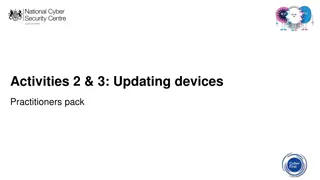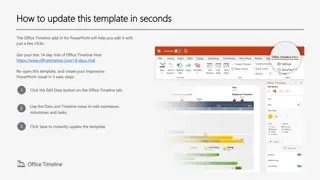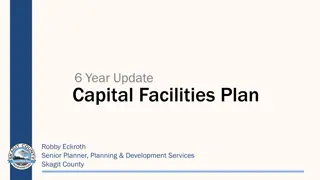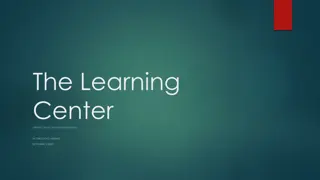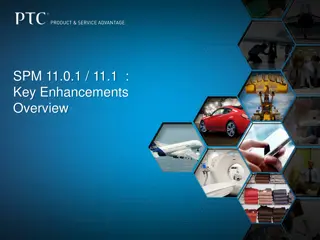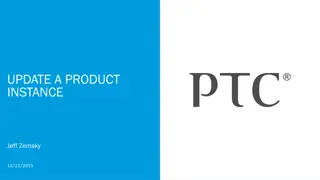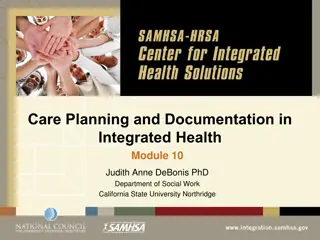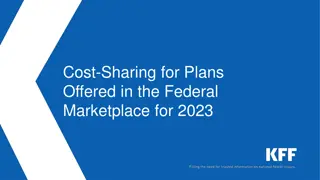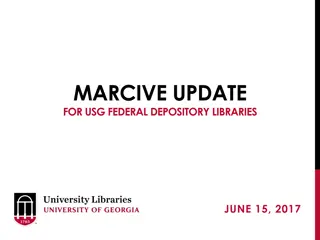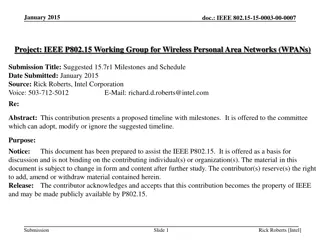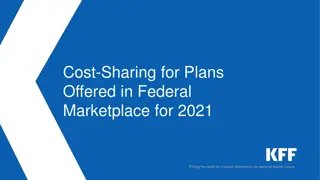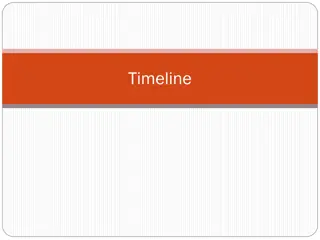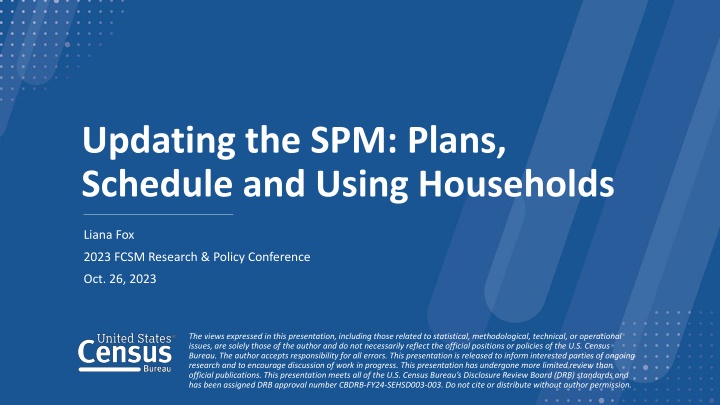
Updating the SPM: Plans and Timeline for Changes
The presentation discusses the evolution and potential timeline for changes in the Supplemental Poverty Measure (SPM), emphasizing consistency, data availability, and transparency in methodology. Details include guidance from the Interagency Technical Working Group, established processes of change, and a proposed timeline for implementing new methodologies.
Download Presentation

Please find below an Image/Link to download the presentation.
The content on the website is provided AS IS for your information and personal use only. It may not be sold, licensed, or shared on other websites without obtaining consent from the author. If you encounter any issues during the download, it is possible that the publisher has removed the file from their server.
You are allowed to download the files provided on this website for personal or commercial use, subject to the condition that they are used lawfully. All files are the property of their respective owners.
The content on the website is provided AS IS for your information and personal use only. It may not be sold, licensed, or shared on other websites without obtaining consent from the author.
E N D
Presentation Transcript
Updating the SPM: Plans, Schedule and Using Households Liana Fox 2023 FCSM Research & Policy Conference Oct. 26, 2023 The views expressed in this presentation, including those related to statistical, methodological, technical, or operational issues, are solely those of the author and do not necessarily reflect the official positions or policies of the U.S. Census Bureau. The author accepts responsibility for all errors. This presentation is released to inform interested parties of ongoing research and to encourage discussion of work in progress. This presentation has undergone more limited review than official publications. This presentation meets all of the U.S. Census Bureau s Disclosure Review Board (DRB) standards and has been assigned DRB approval number CBDRB-FY24-SEHSD003-003. Do not cite or distribute without author permission.
Overview Thank you to the report authors & CNSTAT staff! All recommendations will be considered alongside research from Census/BLS and external researchers Census and BLS will continue working with our Interagency Technical Working Group (ITWG) on the SPM 2
ITWG Guidance SPM should continually evolve, improving due to changes in data, methodology or research Priority should be placed on consistency between threshold and resource definitions, data availability, simplicity in estimation, stability of the measure over time, and ease in explaining methodology (ITWG, 2010) Changes were made in 2021 at 10-year anniversary of SPM 3
Established Process of Change Small adjustments/code updates can be made annually Large changes can be made every 5-10 years after multi-year period of research and stakeholder engagement Expectation that any changes will be detailed in a working paper Presented at 2+ academic conferences Presented at SPM ITWG meetings Presented at Spring Expert Meetings Tension between timeliness and appetite for change Transparency and public trust are crucial 4
Potential Timeline for SPM Changes September 2026 Release of Poverty report using new methodology September 2025 ITWG decides on changes Spring 2025 Expert Meeting Spring 2024 Expert Meeting 2023 2024 2025 2026 April 2023 September 2026 Working papers and conference presentations discussing potential changes to the measure September 2025 September 2026 Research showing the impact of the changes on 2024 SPM rates - including research file. 5
Current Resource Sharing Units for Poverty Measurement Mother of Woman with Child Unmarried Couple with Child Unrelated Individual 7
Current Resource Sharing Units for Poverty Measurement Family: Individuals residing together and related by birth, marriage and adoption Mother of Woman with Child Unmarried Couple with Child Unrelated Individual 8
Current Resource Sharing Units for Poverty Measurement SPM Unit: Families + unmarried partners and their relatives, unrelated children under 15 and foster children under 22 Mother of Woman with Child Unmarried Couple with Child Unrelated Individual 9
Current Resource Sharing Units for Poverty Measurement Household: Everyone living together under one roof Mother of Woman with Child Unmarried Couple with Child Unrelated Individual 10
Current Resource Sharing Units for Poverty Measurement Official Poverty Families Supplemental Poverty Units Household Individuals residing together and related by birth, marriage and adoption Individuals residing together and related by birth, marriage and adoption Individuals residing together and related by birth, marriage and adoption + Unmarried partners and their relatives + Unmarried partners and their relatives + Unrelated children < 15 years old + Foster children <22 years old + Unrelated children < 15 years old + Foster children <22 years old +Unrelated Individuals 11
Motivation for Moving to the Household More consistent with international poverty measurement More intuitive/easier to understand Increases transparency Simplicity--more transferability to other surveys 12
Potential Concerns Largest impact on most vulnerable populations Do people living in households actually share resources? Housing and utilities Maybe food Likely not other essentials like clothing 13
Who is Impacted? Change in Unit 4% Number of SPM Units/Household % of People 1 95.7% 2 2.9% 3+ 1.3% No Change 96% Note: Details may not sum to totals due to rounding. Source: U.S. Census Bureau, Current Population Survey, 2023 Annual Social and Economic Supplement (CPS ASEC). 14
Types of Households Impacted Number of SPM Families (2+ people) Number of Solo Units 0 1 2 0 -- -- 4.0% 1 -- 32.8% 1.0% 2 31.9% 6.9% 0.6% 3 12.6% 1.9% S 4 5+ 5.7% 2.0% S S -- -- S: Estimate is withheld due to small sample size. Note: Details may not sum to totals due to rounding. Source: U.S. Census Bureau, Current Population Survey, 2023 Annual Social and Economic Supplement (CPS ASEC). 15
Types of Households Impacted Number of SPM Families (2+ people) Number of Solo Units 0 1 2 0 -- -- 4.0% 1 -- 32.8% 1.0% 2 31.9% 6.9% 0.6% 3 12.6% 1.9% S 4 5+ 5.7% 2.0% S S -- -- Roommates All 1 person SPM Units: 52.3% S: Estimate is withheld due to small sample size. Note: Details may not sum to totals due to rounding. Source: U.S. Census Bureau, Current Population Survey, 2023 Annual Social and Economic Supplement (CPS ASEC). 16
Types of Households Impacted Number of SPM Families (2+ people) Multiple Families: 4.0% Number of Solo Units 0 1 2 0 -- -- 4.0% 1 -- 32.8% 1.0% 2 31.9% 6.9% 0.6% 3 12.6% 1.9% S 4 5+ 5.7% 2.0% S S -- -- Roommates All 1 person SPM Units: 52.3% S: Estimate is withheld due to small sample size. Note: Details may not sum to totals due to rounding. Source: U.S. Census Bureau, Current Population Survey, 2023 Annual Social and Economic Supplement (CPS ASEC). 17
Types of Households Impacted Number of SPM Families (2+ people) Multiple Families: 4.0% Number of Solo Units 0 1 2 0 -- -- 4.0% 1 -- 32.8% 1.0% 2 31.9% 6.9% 0.6% 3 12.6% 1.9% S 4 5+ 5.7% 2.0% S S -- -- Roommates All 1 person SPM Units: 52.3% Family + Extra: 43.7% S: Estimate is withheld due to small sample size. Note: Details may not sum to totals due to rounding. Source: U.S. Census Bureau, Current Population Survey, 2023 Annual Social and Economic Supplement (CPS ASEC). 18
Demographics of Individuals Impacted Residence Housing Tenure Status Age 65+ 8% Outside MSAs, 9% Under 18 8% Owner with mortgage, 25% 55-64 11% Inside principal cities, 44% 45-54 10% 18-26 35% Renter, 60% Outside principal cities, 47% Owner, no mortgage, 15% 35-44 12% 27-34 16% Source: U.S. Census Bureau, Current Population Survey, 2023 Annual Social and Economic Supplement (CPS ASEC). 19
Impact on 2022 SPM Poverty Rates * An asterisk following an estimate indicates difference is statistically different from zero at the 90 percent confidence level. Note: Details may not sum to totals due to rounding Source: U.S. Census Bureau, Current Population Survey, 2023 Annual Social and Economic Supplement (CPS ASEC). 20
Impact on 2022 SPM Poverty Rates * An asterisk following an estimate indicates difference is statistically different from zero at the 90 percent confidence level. Note: Details may not sum to totals due to rounding Source: U.S. Census Bureau, Current Population Survey, 2023 Annual Social and Economic Supplement (CPS ASEC). 21
Impact on 2022 SPM Poverty Rates * An asterisk following an estimate indicates difference is statistically different from zero at the 90 percent confidence level. Note: Details may not sum to totals due to rounding Source: U.S. Census Bureau, Current Population Survey, 2023 Annual Social and Economic Supplement (CPS ASEC). 22
Impact on 2022 SPM Poverty Rates * An asterisk following an estimate indicates difference is statistically different from zero at the 90 percent confidence level. Note: Details may not sum to totals due to rounding Source: U.S. Census Bureau, Current Population Survey, 2023 Annual Social and Economic Supplement (CPS ASEC). 23
Impact on 2022 SPM Poverty Rates * An asterisk following an estimate indicates difference is statistically different from zero at the 90 percent confidence level. Note: Details may not sum to totals due to rounding Source: U.S. Census Bureau, Current Population Survey, 2023 Annual Social and Economic Supplement (CPS ASEC). 24
Additional Considerations and Next Steps Continued work on: Change in equivalence scales ( ?) Look at additional years Additional exploration of unit changers Next Steps: Integrate thresholds based on household units Release working paper 25
Thank You LIANA.E.FOX@CENSUS.GOV



